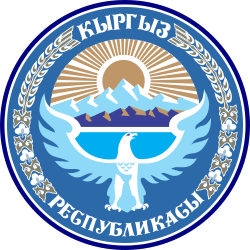Elections in Kyrgyzstan
 |
| This article is part of a series on the politics and government of Kyrgyzstan |
| Constitution |
| Legislative |
|
Related topics |
Kyrgyzstan elects on the national level a head of state - the president - and a legislature. The president is elected for atenure of single six-year term by the people (previously, the term length was four years and briefly five years).[1] The Supreme Council (Joghorku Keneš) 90 members filled by proportional representation.
Latest elections
2010 Parliamentary election
| Parties | Votes | % of votes cast | % by eligible voters | Seats |
|---|---|---|---|---|
| Ata-Zhurt | 266,923 | 16.10% | 8.89% | 28 |
| SDPK | 241,528 | 14.55% | 8.04% | 26 |
| Ar-Namys | 232,682 | 14.02% | 7.74% | 25 |
| Respublika Party of Kyrgyzstan | 217,601 | 13.12% | 7.24% | 23 |
| Ata-Meken | 168,218 | 10.13% | 5.60% | 18 |
| Butun Kyrgyzstan | 145,455 | 8.76% | 4.84% | — |
| Akshumkar | 78,952 | 4.76% | 2.63% | — |
| Zamandash | 63,435 | 3.82% | 2.11% | — |
| Other Parties | 244,703 | 14.74% | 7.77% | — |
| Not voting/casting invalid vote | 45.14% | — | ||
| Total | 100.00% | 100.00% | 120 | |
| Turnout: 1,679,538 (55.90%) | ||||
| Source: Shailoo | ||||
2005 Presidential election
| Candidates | Votes | % |
|---|---|---|
| Kurmanbek Bakiyev | 1,312,174 | 88.9 |
| Tursunbai Bakir Uulu | 56,065 | 3.8 |
| Akbaraly Aitikeev | 52,671 | 3.6 |
| Zhapar Dzheksheyev | 13,821 | 0.9 |
| Toktayym Ümötalieva | 8,111 | 0.6 |
| Keneshbek Dushebaev | 7,424 | 0.5 |
| Against all candidates | 12,771 | 0.9 |
| Total (turnout %) | 100.0 |
Parliamentary election
2005
69 seats were won by the ruling party and 6 were one by the opposition. Observers said there "some technical improvements over the first round" but stressed that there remained "significant shortcomings." Following the Tulip Revolution the incomplete results were never complete and the interim president, Kurmanbek Bakiev initially postponed a new round of election to later in the year, but subsequently put them off beyond 2005.
2000
- Assembly of People's Representatives - 20 February and 12 March 2000
- Legislative Assembly - 20 February and 12 March 2000
Election results: Total seats by party in the Supreme Council were as follows:
- Union of Democratic Forces - 12 (Naryn, Jalalabad)
- Communists - 6 (Bishkek, Tokmok, Isilkul, Talas, Osh)
- My Country Party of Action - 4
- Independents - 73
- Other - 10
note: These results include both the Assembly of People's Representatives and the Legislative Assembly.
1995
- Assembly of People's Representatives - 5 February 1995
note: not all of the 70 seats were filled at the 5 February 1995 elections; as a result, run-off elections were held at later dates; the assembly meets twice yearly
- Legislative Assembly - 5 February 1995
note: not all of the 35 seats were filled at the 5 February 1995 elections; as a result, run-off elections were held at later dates
note: the legislature became bicameral for the 5 February 1995 elections